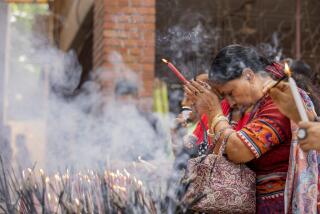A ‘living virgin goddess’ comes down to earth in Nepal
- Share via
Reporting from Katmandu, Nepal — Being a “living virgin goddess” isn’t all it’s cracked up to be.
Imagine the bruising you get when you tumble back to earth.
It’s been two decades since Rashmila Shakya, a 33-year-old with the sweet smile and gentle voice, reached puberty and “retired” as a royal kumari, as the young Nepalese goddesses are known.
Sitting in her modest bedroom next to an oversized Mickey Mouse doll, she describes being selected when she was 4, after a kumari caretaker ensured she had an auspicious horoscope and bore no physical defects in line with “32 perfections” — including thighs like a deer, eyelashes like a cow and a voice as clear as a duck.
“I don’t remember much from the beginning because I was so young,” she says. “By the time you’re around 6 or 7, you start realizing you’re the living goddess and get used to being worshiped.”
By tradition, one royal kumari at a time reigns before the mantle is passed to the next little girl. Local areas have lesser living goddesses, but Katmandu’s was traditionally the only one linked directly to the king. Since the end of Nepal’s monarchy in 2008, this centuries-old practice has come under attack from Maoists, politicians and human rights groups as exploitative and outdated. Shakya hopes it continues despite the many problems she faced readjusting to normal life.
“It’s an important part of our culture, a way for foreigners to know about Nepal,” she says.
Once chosen, Shakya was whisked off to a palace-temple to be waited on by eight attendants for the next eight years, staying indoors except for 13 annual festivals when she appeared on a chariot — her feet never touching the ground — wearing a painted third eye.
Fed specially prepared meals that she ate while seated alone on a raised platform, her only playmates were the caretaker’s children. She received a stream of supplicants and almost no education, because a goddess knows everything.
“I was left with nothing but a gold brocade dress and my memories,” she wrote in her 2005 memoir, “From Goddess to Mortal.” “I was virtually illiterate.”
And virtually spoiled, her family concluded. Although her parents and siblings had visited her freely at the temple, they weren’t allowed to stay overnight, and living together again was a difficult transition for everyone. They “worshiped” her for a few days but soon leaned on her to help with the cooking and cleaning, skills she had not practiced.
She recalls the shock of sharing a bedroom with her sisters, coping without attendants, watching black-and-white TV. “Was this little hovel to be my home?” she remembers thinking.
After years of pampering, she also had to learn how to walk in shoes, choose her own clothes, buy chocolates (people always gave those to you) and make friends (a bit different from ordering people around).
Resolved not to waste her life, however, she started school sitting with 5-year-olds in tiny desks before eventually catching up. At one point she got a score of 17% on a general knowledge test, which said it all.
Eventually her determination paid off, however, as she became the first former kumari to travel abroad or graduate from college. She’s now a software developer living in the family home. She enjoys shopping and watching Bollywood movies in her spare time.
She’s also fought to wrench the system out of the Middle Ages, helping ensure that her successors received a proper education. Kumari are now tutored inside the temple, which eases the transition to normal life.
Shakya looks uncomfortable when asked about marriage. Although there’s no rule against a former goddess marrying — and several have — superstition holds that husbands of ex-kumari die early.
“It’s considered bad luck,” says Manjushree Thapa, author of “Forget Kathmandu.” “And it’s emasculating to be married to a goddess.”
Shakya blushes when asked whether men find her intimidating. “I can’t go inside people’s heads,” she says. “No one says they’re afraid outright.”
Under the kumari system, which dates to 769, 1615 or 1768, depending on the source, the young girls are considered an earthly manifestation of the powerful goddess Taleju Bhawani who, offended by a king, would be appeased only by a young virgin. Shakya, like all kumari, was selected from among the Newari Shakya community of jewelry makers, part of a former monk caste viewed as able to appease the angry Taleju.
This link between god and king traditionally meant that any misfortune to kumari signaled that Nepal’s Hindu monarch had lost his heavenly mandate, hence the rules against her playing outside lest she have an accident.
Nepali society hasn’t fully resolved how to handle the royal kumari system in a post-royal age, with the occasional politician still soliciting her blessing for successful rule despite representing a secular state. Adding to the superstitious linkage, Shakya recalls being sick and weepy only once during her eight-year reign, over several days in early 1990 when democracy took hold amid curfews and street demonstrations.
As modernity has seeped into the mountain kingdom after the 240-year monarchy, more people question the institution’s viability and fewer parents are offering up their daughters for this life. Maoists have condemned it as a relic of feudalism, the former defense minister termed it child exploitation, and Nepal’s Supreme Court last August ordered the government to safeguard kumari health and human rights.
The current kumari, Matina Shakya, 4, is the first to serve under a republic. Her father, Pratapman Shakya, defends the institution and its traditional role between ruler and god. At the same time, he denies that Nepal’s current political gridlock — involving a power struggle between Maoists and more established parties — is his daughter’s fault.
“It’s the other way around,” he says, seated in a tiny, low-ceilinged bedroom with well-worn carpets in the family home in downtown Katmandu. “The political leaders have so many problems because they haven’t come to my daughter for a blessing.”
At the Kumari Ghar, or palace-temple in central Katmandu, a five-story red brick courtyard building with dark wood inlay built in 1757, signs warn foreigners not to enter the kumari’s living quarters or take pictures if she peeks out. (Potential beef-eaters are considered unclean.) A few minutes later, a little girl’s head briefly appears before darting back.
At the Kumari Bakery next door, VIPs stop in to buy the brightly colored cupcakes on dirty glass shelves when visiting the living goddess, something that occurs daily as people solicit her blessing. “I can’t be sure she eats my treats,” says baker Kamal Shrestha, 20. “But I sure hope so.”
Perhaps due in part to the age of the institution or the child goddess’ colorful presence at Nepal’s many festivals, the kumari tradition remains popular amid residual belief that she does connect Nepal’s leadership and the gods. “There’s a belief the kumari gives the state more legitimacy,” says Suresh Dhakal, an anthropologist with Katmandu’s Tribhuvan University. “So even under a republic, it’ll continue for some time.”
Others, like sociologist Sanjeev Pokhrel, expect it to gradually lose its meaning, evolving into little more than a cultural sideshow and tourist attraction, “like the panda for China.”
Shakya, who has long been interested in the arts, dreams of one day designing houses. In the meantime, she remains a minor celebrity around Katmandu.
“People still recognize me on the street, which is a good feeling,” she says. “They don’t tease me about ‘descending from heaven,’ but they are curious.”
More to Read
Sign up for Essential California
The most important California stories and recommendations in your inbox every morning.
You may occasionally receive promotional content from the Los Angeles Times.










